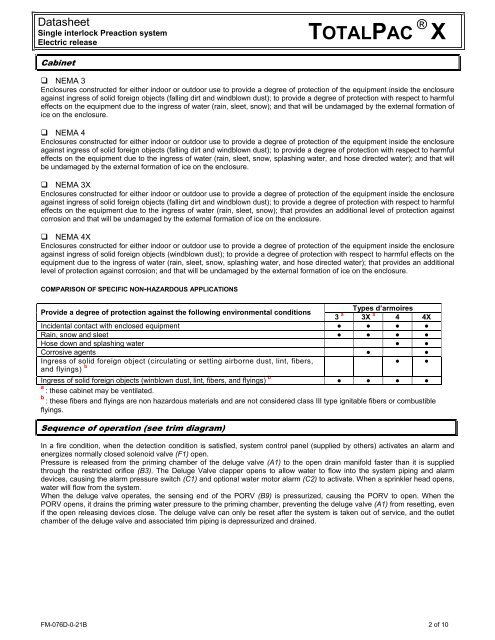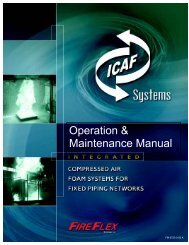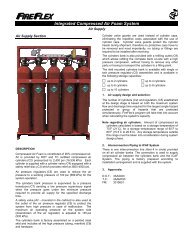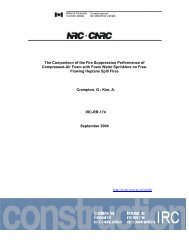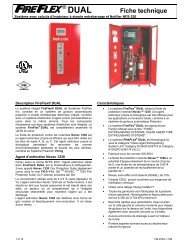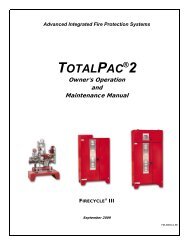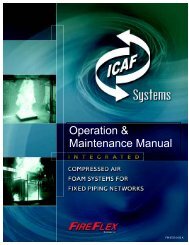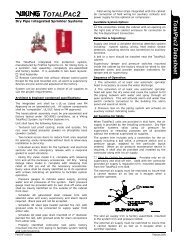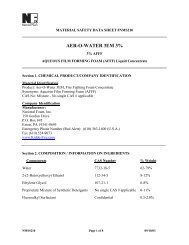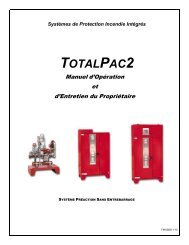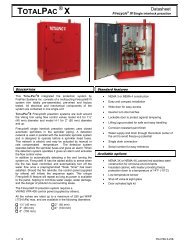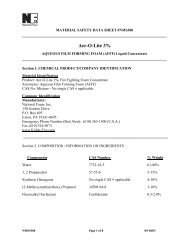TotalPac®X Single Interlock electric release - FIREFLEX SYSTEMS
TotalPac®X Single Interlock electric release - FIREFLEX SYSTEMS
TotalPac®X Single Interlock electric release - FIREFLEX SYSTEMS
Create successful ePaper yourself
Turn your PDF publications into a flip-book with our unique Google optimized e-Paper software.
Datasheet<br />
<strong>Single</strong> interlock Preaction system<br />
Electric <strong>release</strong><br />
TOTALPAC ® X<br />
Cabinet<br />
NEMA 3<br />
Enclosures constructed for either indoor or outdoor use to provide a degree of protection of the equipment inside the enclosure<br />
against ingress of solid foreign objects (falling dirt and windblown dust); to provide a degree of protection with respect to harmful<br />
effects on the equipment due to the ingress of water (rain, sleet, snow); and that will be undamaged by the external formation of<br />
ice on the enclosure.<br />
NEMA 4<br />
Enclosures constructed for either indoor or outdoor use to provide a degree of protection of the equipment inside the enclosure<br />
against ingress of solid foreign objects (falling dirt and windblown dust); to provide a degree of protection with respect to harmful<br />
effects on the equipment due to the ingress of water (rain, sleet, snow, splashing water, and hose directed water); and that will<br />
be undamaged by the external formation of ice on the enclosure.<br />
NEMA 3X<br />
Enclosures constructed for either indoor or outdoor use to provide a degree of protection of the equipment inside the enclosure<br />
against ingress of solid foreign objects (falling dirt and windblown dust); to provide a degree of protection with respect to harmful<br />
effects on the equipment due to the ingress of water (rain, sleet, snow); that provides an additional level of protection against<br />
corrosion and that will be undamaged by the external formation of ice on the enclosure.<br />
NEMA 4X<br />
Enclosures constructed for either indoor or outdoor use to provide a degree of protection of the equipment inside the enclosure<br />
against ingress of solid foreign objects (windblown dust); to provide a degree of protection with respect to harmful effects on the<br />
equipment due to the ingress of water (rain, sleet, snow, splashing water, and hose directed water); that provides an additional<br />
level of protection against corrosion; and that will be undamaged by the external formation of ice on the enclosure.<br />
COMPARISON OF SPECIFIC NON-HAZARDOUS APPLICATIONS<br />
Provide a degree of protection against the following environmental conditions<br />
3 a Types d’armoires<br />
3X a 4 4X<br />
Incidental contact with enclosed equipment ● ● ● ●<br />
Rain, snow and sleet ● ● ● ●<br />
Hose down and splashing water ● ●<br />
Corrosive agents ● ●<br />
Ingress of solid foreign object (circulating or setting airborne dust, lint, fibers,<br />
and flyings) b ● ●<br />
Ingress of solid foreign objects (winblown dust, lint, fibers, and flyings) b ● ● ● ●<br />
a : these cabinet may be ventilated.<br />
b : these fibers and flyings are non hazardous materials and are not considered class III type ignitable fibers or combustible<br />
flyings.<br />
Sequence of operation (see trim diagram)<br />
In a fire condition, when the detection condition is satisfied, system control panel (supplied by others) activates an alarm and<br />
energizes normally closed solenoid valve (F1) open.<br />
Pressure is <strong>release</strong>d from the priming chamber of the deluge valve (A1) to the open drain manifold faster than it is supplied<br />
through the restricted orifice (B3). The Deluge Valve clapper opens to allow water to flow into the system piping and alarm<br />
devices, causing the alarm pressure switch (C1) and optional water motor alarm (C2) to activate. When a sprinkler head opens,<br />
water will flow from the system.<br />
When the deluge valve operates, the sensing end of the PORV (B9) is pressurized, causing the PORV to open. When the<br />
PORV opens, it drains the priming water pressure to the priming chamber, preventing the deluge valve (A1) from resetting, even<br />
if the open releasing devices close. The deluge valve can only be reset after the system is taken out of service, and the outlet<br />
chamber of the deluge valve and associated trim piping is depressurized and drained.<br />
FM-076D-0-21B 2 of 10


